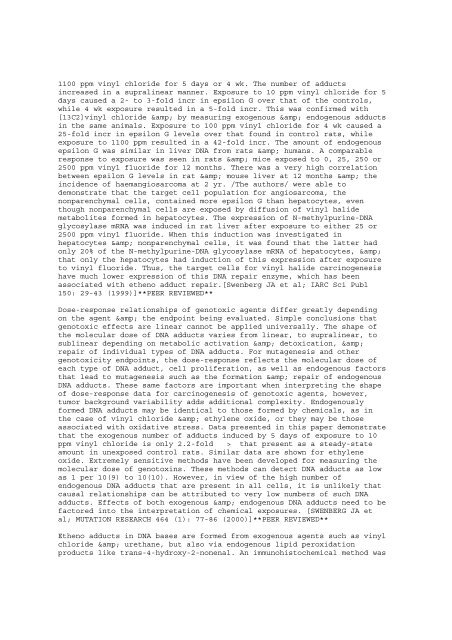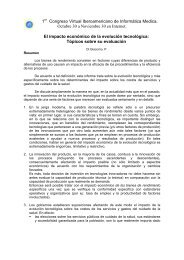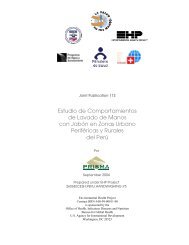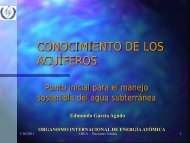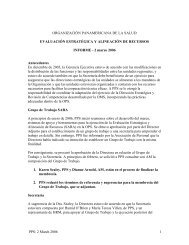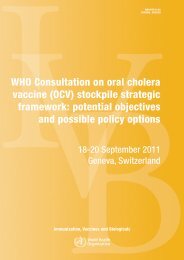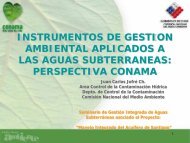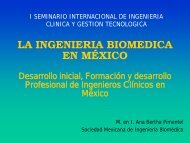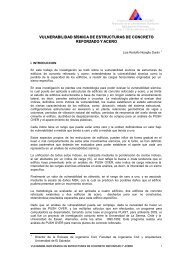a database of the National Library of M
a database of the National Library of M
a database of the National Library of M
You also want an ePaper? Increase the reach of your titles
YUMPU automatically turns print PDFs into web optimized ePapers that Google loves.
1100 ppm vinyl chloride for 5 days or 4 wk. The number <strong>of</strong> adductsincreased in a supralinear manner. Exposure to 10 ppm vinyl chloride for 5days caused a 2- to 3-fold incr in epsilon G over that <strong>of</strong> <strong>the</strong> controls,while 4 wk exposure resulted in a 5-fold incr. This was confirmed with[13C2]vinyl chloride & by measuring exogenous & endogenous adductsin <strong>the</strong> same animals. Exposure to 100 ppm vinyl chloride for 4 wk caused a25-fold incr in epsilon G levels over that found in control rats, whileexposure to 1100 ppm resulted in a 42-fold incr. The amount <strong>of</strong> endogenousepsilon G was similar in liver DNA from rats & humans. A comparableresponse to exposure was seen in rats & mice exposed to 0, 25, 250 or2500 ppm vinyl fluoride for 12 months. There was a very high correlationbetween epsilon G levels in rat & mouse liver at 12 months & <strong>the</strong>incidence <strong>of</strong> haemangiosarcoma at 2 yr. /The authors/ were able todemonstrate that <strong>the</strong> target cell population for angiosarcoma, <strong>the</strong>nonparenchymal cells, contained more epsilon G than hepatocytes, eventhough nonparenchymal cells are exposed by diffusion <strong>of</strong> vinyl halidemetabolites formed in hepatocytes. The expression <strong>of</strong> N-methylpurine-DNAglycosylase mRNA was induced in rat liver after exposure to ei<strong>the</strong>r 25 or2500 ppm vinyl fluoride. When this induction was investigated inhepatocytes & nonparenchymal cells, it was found that <strong>the</strong> latter hadonly 20% <strong>of</strong> <strong>the</strong> N-methylpurine-DNA glycosylase mRNA <strong>of</strong> hepatocytes, &that only <strong>the</strong> hepatocytes had induction <strong>of</strong> this expression after exposureto vinyl fluoride. Thus, <strong>the</strong> target cells for vinyl halide carcinogenesishave much lower expression <strong>of</strong> this DNA repair enzyme, which has beenassociated with e<strong>the</strong>no adduct repair.[Swenberg JA et al; IARC Sci Publ150: 29-43 (1999)]**PEER REVIEWED**Dose-response relationships <strong>of</strong> genotoxic agents differ greatly dependingon <strong>the</strong> agent & <strong>the</strong> endpoint being evaluated. Simple conclusions thatgenotoxic effects are linear cannot be applied universally. The shape <strong>of</strong><strong>the</strong> molecular dose <strong>of</strong> DNA adducts varies from linear, to supralinear, tosublinear depending on metabolic activation & detoxication, &repair <strong>of</strong> individual types <strong>of</strong> DNA adducts. For mutagenesis and o<strong>the</strong>rgenotoxicity endpoints, <strong>the</strong> dose-response reflects <strong>the</strong> molecular dose <strong>of</strong>each type <strong>of</strong> DNA adduct, cell proliferation, as well as endogenous factorsthat lead to mutagenesis such as <strong>the</strong> formation & repair <strong>of</strong> endogenousDNA adducts. These same factors are important when interpreting <strong>the</strong> shape<strong>of</strong> dose-response data for carcinogenesis <strong>of</strong> genotoxic agents, however,tumor background variability adds additional complexity. Endogenouslyformed DNA adducts may be identical to those formed by chemicals, as in<strong>the</strong> case <strong>of</strong> vinyl chloride & ethylene oxide, or <strong>the</strong>y may be thoseassociated with oxidative stress. Data presented in this paper demonstratethat <strong>the</strong> exogenous number <strong>of</strong> adducts induced by 5 days <strong>of</strong> exposure to 10ppm vinyl chloride is only 2.2-fold > that present as a steady-stateamount in unexposed control rats. Similar data are shown for ethyleneoxide. Extremely sensitive methods have been developed for measuring <strong>the</strong>molecular dose <strong>of</strong> genotoxins. These methods can detect DNA adducts as lowas 1 per 10(9) to 10(10). However, in view <strong>of</strong> <strong>the</strong> high number <strong>of</strong>endogenous DNA adducts that are present in all cells, it is unlikely thatcausal relationships can be attributed to very low numbers <strong>of</strong> such DNAadducts. Effects <strong>of</strong> both exogenous & endogenous DNA adducts need to befactored into <strong>the</strong> interpretation <strong>of</strong> chemical exposures. [SWENBERG JA etal; MUTATION RESEARCH 464 (1): 77-86 (2000)]**PEER REVIEWED**E<strong>the</strong>no adducts in DNA bases are formed from exogenous agents such as vinylchloride & urethane, but also via endogenous lipid peroxidationproducts like trans-4-hydroxy-2-nonenal. An immunohistochemical method was


